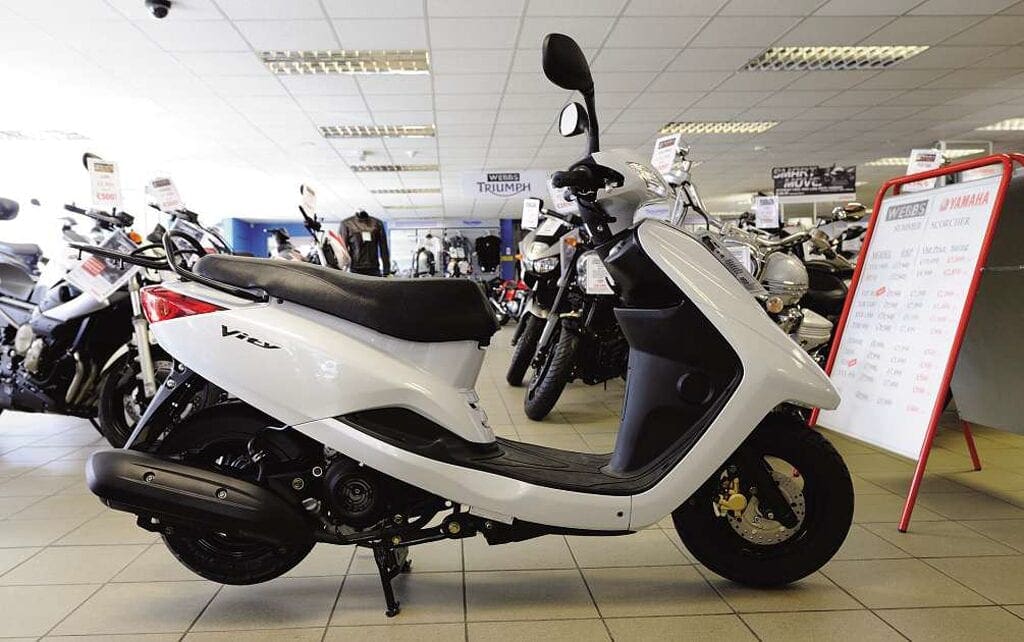
Like most things, it all comes down to budget. And don’t forget, you need to have money left for a decent helmet, riding suit, gloves and boots too. If you are lucky enough to have a £3000-4000 budget, buy new and buy Japanese or Italian.
The latest Honda, Yamaha, Suzuki, Aprilia, Gilera and Vespa scooters are superb machines. They are nippy away from the lights, surprisingly quick on dual carriageways, economical and well built too.
Buying new gives peace of mind, a full manufacturer’s warranty and there are often good deals on fl nance which a smart dealer will extend to cover the kit you buy too. Plus, the resale values are much stronger.
Enjoy everything More Bikes by reading monthly newspaper, Read FREE Online.
For those of us with a bit less money to spend, it often comes down to a new Chinese scoot or second-hand Japanese machine. And this is where it gets tricky.
Read the checklist overleaf and you’ll see that buying a used scooter can be a minefield, but if you buy from a dealer or use your loaf in a private sale, you can still get a good deal.
The Chinese and Indian scooters are getting better -more refined performance, better economy and more reliable too -but they still aren’t as good as the Japanese. And that’s fine -you are, after all paying a lot less money. There are two main problems with the cheaper scooters.
The most annoying ones are down to reliability, which is mostly okay, but not perfect and because the Chinese manufacturers rarely have official importers set up like the Japanese makers, the quality of spares supply and product knowledge among dealers is much more variable. If you are mechanically minded or know someone who is, then a cheaper new model could be a good buy.
lnbetween are the Taiwanese and Korean scooters. Some are almost as good as the Japanese and Italians, just lacking a little of the refinement and that final few percent of buiId quality. They are more expensive than the Chinese but cheaper than the Japanese.
Buying a second-hand scooter privately
The main thing is to ask lots of questions before you go to see it. And if buying on eBay, then be very, very wary. The perfect private sale scooter has been bought by a mature commuter, ridden gently and serviced regularly, so ask the questions that will find this out. Expect to find an envelope full of receipts for work done and parts changed.
When you go to view it, try and make a judgment about the person selling it. What kind of rider are they? Can they answer your maintenance questions convincingly.
How long have they had it, why are they selling it? And make sure you have a good look round the bike.Take a mate with you who isn’t wide eyed and desperate to buy it and ask them to look for faults. Take your time and if you aren’t sure, leave your details and go away to think about it.
Buying on eBay is fraught with problems for new riders. It’s very easy for a canny seller to hide faults in the description, which means if you win it and the bike isn’t quite as good as you’d hoped, it’s you that appears the bad guy and the time waster. So ask questions like “has it been crashed” or “do you have a service record for it” and then if it turns out to be damaged, it’s them on the back foot.
Finally, don’t forget that if you want to have a test ride on the road, you’ll need insurance and the right licence/CST certificate and even then, many sellers won’t let you ride it without the money in their hand. Some test riders turn out to be bike thieves and don’t come back.
Secondhand Scooter Checklist
Engine
Smaller scooter engines run close to flat out for most of their lives and so regular oil changes are essential to prevent wear. Most engine wear occurs when the motor is cold and the oil hasn’t had chance to circulate properly.
A caring owner gives their bike a minute or two to warm up before revving it hard, which makes an enormous difference.
Two-stroke or four-stroke?
Two-stroke engines burn off their engine oil and so you have to top it up with special two stroke oil every few hundred miles. Twostrokes are much quicker for a given engine capacity and are simpler (cheaper) to service and repair when they go wrong. But four-stroke engines are more reliable if a little slower away from the lights. Plus, you don’t have to keep topping up the oil (but you still need to check the level from time to time).
General condition
The biggest problem is lack of maintenance from car-drivers-turned-commuters or new riders who know no better. We’ve seen twoyear-old bikes that are wrecked by neglect, but we’ve also seen identical machines that are mint because the owner sticks to the service schedule.
Be aware though that under the shiny plastics you might find a pile of rusty poo. many scooters are made of cheap metal with minimal corrosion protection.Two winters and they are scrap.
Wheels
Traditional scooters have 12 inch or 14 inch wheels with fat, chunky tyres. They are hard wearing considering the number of potholes they crunch in and out of, but you should always check them for cracks, corrosion and bent or damaged rims. Bigger wheeled scooters are a little bit tougher, but you should still check.
Tyres
Many scooter riders don’t realise how quickly a tyre can wear out so make sure that they are in good condition and have at least the legal minimum (1 mm) of tread remaining.
Suspension
Scooter suspension gets a hard time, so check the fork legs and shock absorbers for signs of oil leaks.
Brakes
As with tyres, many riders don’t check the wear on brake pads and rely on a dealer informing them at service time.This is fine if the scooter is serviced regularly, but once the scooter gets to be a few years old many are barely serviced at all.
Check the wear indicators on drum brakes and on disc brakes have a look along the edges of the disc where the caliper bites to make sure you can still see plenty of pad material on the brake pads.
Also check brake discs for scoring or signs of a lip building up around the rim where the rest of the disc has worn. If the brake lever pulses when you apply the brakes it indicates either a warped disc or worn brake drum.
Electrics
Although most scooters run 12v electrics these days, the batteries are tiny and because many journeys are short, stop-start affairs the battery gets a lot of use and most need replacing every three to five years. Check that all the electrics work including the horn and the electric starter.
Lights
Make sure that they all work.The headlight should get brighter when you rev the bike, which indicates that the electrical charging system is working. Indicators should flash quickly and evenly. If one stays on or flashes very quickly then chances are that either the bulb or the connection in the other one on that side is faulty.
Crash damage
Lots of scooters get crashed. Mostly it’s not serious – just a wobble or a topple and the only damage is a scuff or scrape on the bodywork. That’s not a problem, but more serious damage is.
Check that with the front wheel facing forward, the handlebars are straight and then, with the scooter on the main stand and the handlebars straight, kneel down by the back wheel and look from the back to the front. The two wheels should be in line. If not, there might be some more serious damage.
Has it been stolen?
Plenty of scooters are nicked, so don’t buy anything without the right paperwork and check that the details on the logbook match those of the scooter. Be suspicious of anything that looks like the ignition has been repaired. An HPI or similar vehicle check is essential when buying privately. It will tell you if the bike has been crashed and written off, stolen or is still on finance.
Advert
Enjoy everything More Bikes by reading the MoreBikes monthly newspaper. Click here to subscribe, or Read FREE Online.



